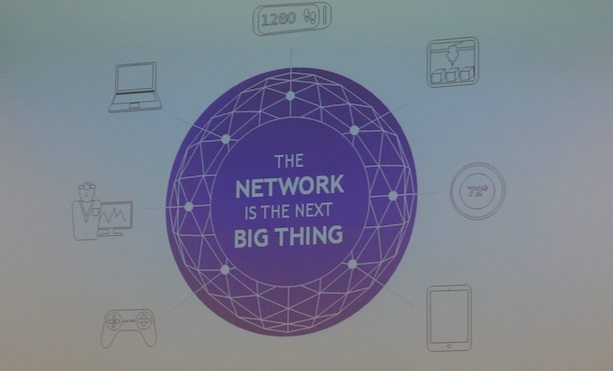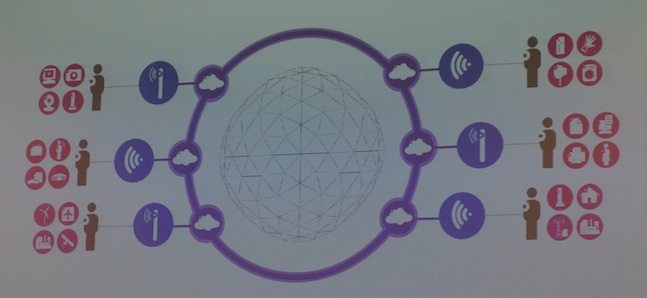I spent yesterday at Alcatel-Lucent/Bell Labs’ annual FutureX Days. This event showcases the topics the research teams are working on to a mix of customers, partners, press and university professors. The top executives of the organization also share their strategic direction. I have to say I was impressed. For all the talk of ALU being on the path to dying, they seemed very alive and well from where I sat.
 Michel Combes, CEO of Alcatel-Lucent was very open on this topic. He was clear about the tough decisions taken to get the company back on track and talked about going from “fighting for their lives” to “fighting to win” today. As they worked through phase 1 of their “shift plan” they held steady on research and development spending while taking substantial cuts in other areas. He attributes this strategy to the company’s current corporate health, saying that 75% of its R&D investment is in Internet Protocol and cloud-related technologies, and that the company has shifted its corporate culture to rely more on partnerships instead of trying to do everything in-house. He talked about the focus of Bell Labs shifting to key areas where there was a 10x improvement needed in ICT functions. The company also added three more R&D locations to focus on specific technology areas – Israel (cloud), United Kingdom (video) and United States (software-defined networks evolution).
Michel Combes, CEO of Alcatel-Lucent was very open on this topic. He was clear about the tough decisions taken to get the company back on track and talked about going from “fighting for their lives” to “fighting to win” today. As they worked through phase 1 of their “shift plan” they held steady on research and development spending while taking substantial cuts in other areas. He attributes this strategy to the company’s current corporate health, saying that 75% of its R&D investment is in Internet Protocol and cloud-related technologies, and that the company has shifted its corporate culture to rely more on partnerships instead of trying to do everything in-house. He talked about the focus of Bell Labs shifting to key areas where there was a 10x improvement needed in ICT functions. The company also added three more R&D locations to focus on specific technology areas – Israel (cloud), United Kingdom (video) and United States (software-defined networks evolution).
Dr. Marcus Weldon, CTO at Alcatel-Lucent and president of Bell Labs, continued the discussion from a technology perspective. He talked about the “Internet of Things” and how it drives the need for cloud functionality at the edge of network. I also heard this from HERE in a discussion about connected cars driving the need for the same. In order to make this vision a reality, everything becomes connected via SDN virtual private networks.
Dr. Hagen Radowski, CEO of MHP Americas – a Porsche company, shared the company’s vision for big data’s relevance and importance in the connected car discussion. He talked about how companies that are obsessed with the customer journey and understand the difference between the brand and the product are best equipped to succeed. When considering how “big” big data actually is, consider these statistics: The world economy grows at about 3.5% to 4% per year, and big data grows at about 40% to 60% per year, with 90% of that data coming from the last two years. Those are some big figures, no pun intended. Some ideas as to what might come in the future? A car that provides suggestions on your route to work based on your preferences.
https://www.youtube.com/watch?v=an1mIUPdgbU
And autonomous intersections, the one looks terrifying to me.
Inmarsat and Alcatel-Lucent also announced plans to work on a project to enable “connected aircraft” with high-speed broadband services over the EU region. In addition to using S-band satellite connectivity, the solution depends on 4G LTE air-to-ground technology, so ALU will adapt their existing LTE technology to work in conjunction with S-band satellite. Except for the fact that I foresee we will never have a quiet zone on the plane again, this is a really great step forward to enable productivity and entertainment while in-flight.
 There were 20 demos available to showcase the areas of work currently being focused on by the Bell Labs team. The demos were categorized into three areas of focus – Future Access, Future Networked-Cloud and Future Experience.
There were 20 demos available to showcase the areas of work currently being focused on by the Bell Labs team. The demos were categorized into three areas of focus – Future Access, Future Networked-Cloud and Future Experience.
Three of those demos were of particular interest to me. The first was related to the use of 5G in support of IoT and the requirement to support a large number of devices with very low latency requirements. This currently is in trial with NTT DoCoMo.
The second is also related to 5G, but for context aware radio access for 5G. The key is to be able to interpret what applications the user is using and where they are, and then optimize their experience around those parameters. By understanding patterns over time they are able to offer predictive network experience assumptions as to what/where the user will go next and what experience is required. This is currently under development in partnership with net-mobile.
The third item is the Blue Cube or “wireless” wireless solution. Basically this is a very low-power, solar/battery-powered small cell for remote locations where the cost of deploying wires doesn’t make an appropriate business case. There’s no wire for backhaul or power and it supports LTE.
All in all, the breadth of the discussions, the forward-looking vision and the passion of the presenters was well worth the attendance. Stories of Alcatel-Lucent’s demise are greatly exaggerated at this point in time.

